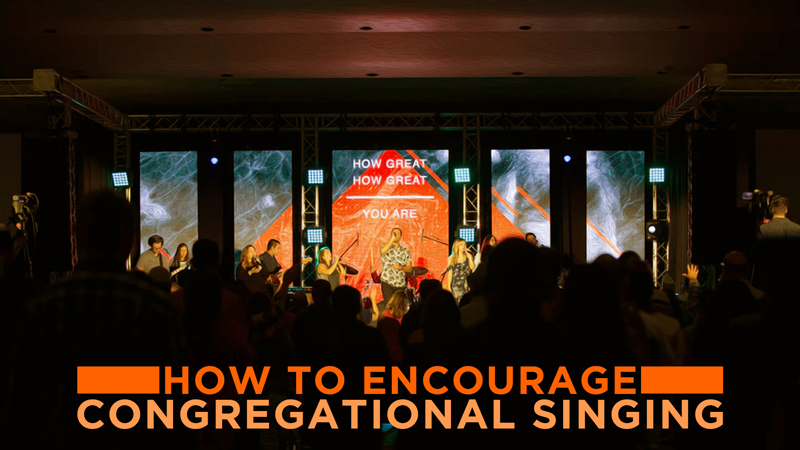I just got back from teaching at one of the most unique and arguably the best attended worship events I’ve ever had the privilege to be involved with: “SING” The Getty Worship Conference, which was held at Brentwood Baptist Church just outside of Nashville, Tennessee.
The theme focused on ways to help our congregations engage in worship. Every speaker, teacher, and artist was asked to focus on that one overarching point. I was given a topic and title ahead of time, and I must confess, I had never given it much thought. It was to be included in the Technology Track and my workshop was supposed to give Sound Operators tips and techniques for helping the congregation to be heard; to encourage their participation; to help them sing.
Church Worship: How To Encourage Congregational Singing – Part 1

My first thought was: “Wow, this is easy! Pull down the Master Fader.” Then I started to think about it more deeply. It’s not really all that simple. There are other major factors contributing to why our congregations are not responding. I researched, read a lot of what other people had to say about it and I will include their thoughts alongside mine in this post.
Sound operators and the sound system certainly play a part, but so does the worship leader and band, as well as the leadership. Let’s not forget acoustics of the building itself and the culture of our specific churches. Recently, one of my elders asked me for advice on how to get our congregation to be reinforced. I wondered if he meant reinforcing them on a recording, as with audience (audience) microphones. He said, “No, I mean like, through the sound system.” I quickly replied, “No, no, no, you don’t want to do that unless you want to hear high-pitched feedback along with singing.”
Never place your ambient (room/audience/crowd) microphones into the main house system. I told him that the reason the congregation is not singing is not that the system is too loud. It’s because they don’t know the songs.
In a place not too far away, long, long ago, the church had a collection of songs that we assembled over time that became part of our fabric. We knew the songs and would sing them, often times from memory, whether it was a hymn or a chorus. They were typically found in a hymnal, a relic in many churches.

I miss it. Don’t get me wrong, I like new songs too but when CCLI has over 300,000 songs in the library, then it’s about time we said “No” to some of them.

If we learn a new song, make sure, Mr. Worship Leader, that it is appropriate for congregational singing. Is it in an easy key to sing? Introduce it to us properly, repeat it in the following weeks so that we actually can learn it over time and let it become a part of our combined repertoire. Limit the new songs to a number that makes sense. How many new songs can we learn in a year? One new song a week doesn’t make much sense. Teaching 40-50 a year? Really?

While I’m talking to you, Miss Creative Arts Pastor, do you have a plan to encourage congregational singing? Are you providing opportunities for the service for them to participate, for example with the band stops playing and we sing acapella together? It’s very refreshing sometimes to just stop and listen.

Is the band arranged with players playing specific parts with dynamics, that is, space between the players so that we hear definition?
Can you hear the person next to you?
“Now, I like Palestrina and I like good Christian rock. So, church musicians, if you want to perform a fine song that requires advanced musicianship, by all means do it. We will listen and pray and enjoy it to the glory of God.
But when you are leading us in singing, then lead us in singing. And turn it down so we are not listening to you—or, even worse, merely enduring you. I know that’s not what you want to happen. But I am telling you that’s what is happening.”
John Stackhouse Christianity Today
In many ways, worship has become a spectator event.
What about the lyric presenter?
“I think we’ve looked at the last slide long enough. Don’t you? You can go to the next verse please.”

One thing I know that works and it’s something that many churches do and many don’t. Incorporate choirs. Every year, my wife Sheri, an amazing vocal coach, speaker, and writer leads the choirs at Bob Kauflin’s Worship God Conferences. She is given a day or two to whip a group of people together, from various parts of the world into a unified conference choir. It never ceases to amaze me how it inspires the congregation to sing out, with passion and gusto. Seeing the choir on the platform sing makes me want to sing.

In the next post Church Worship: How To Encourage Congregational Singing – Part 2, I will focus on what the sound operator is responsible for and look at the sound system itself to see where we can make improvements so that the congregation is getting a mix that is balanced, at the right level, for everyone in the sanctuary. Stay tuned. Sound operators are not off the hook.

